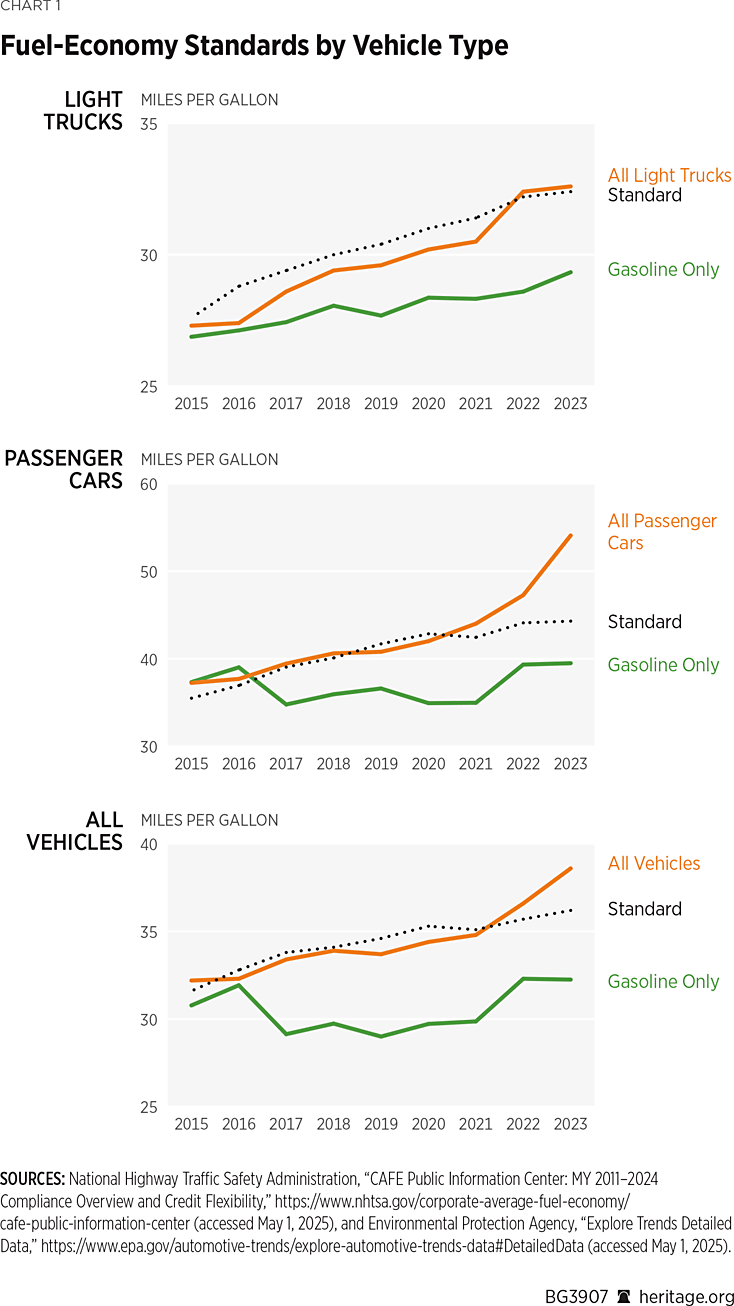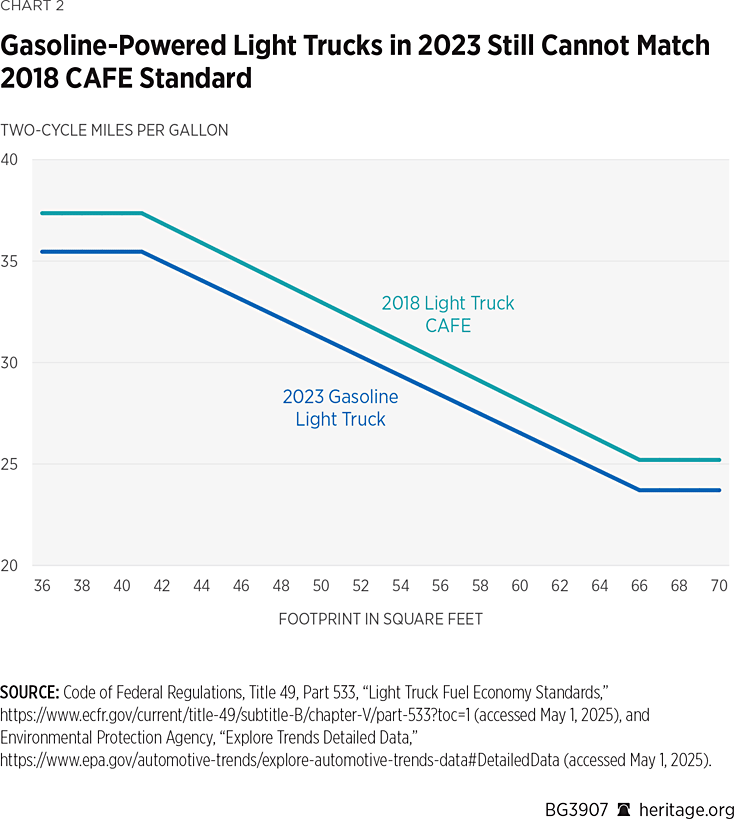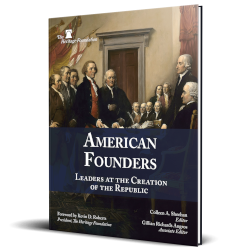Fuel economy standards, among many other regulatory requirements, were established through congressional authority granted by the Energy Policy Conservation Act (EPCA) of 1975. The EPCA’s fundamental purpose was to reduce America’s dependence on foreign oil imports in response to the Arab oil embargo that threatened America’s energy security.
Congress designed the Corporate Average Fuel Economy (CAFE) standards to encourage American and foreign automakers to develop more fuel-efficient vehicles for the American market. The intention of the CAFE standards under the EPCA was to, as the name implies, regulate fuel economy, with “fuel” to include gasoline and diesel to further reduce U.S. dependence on foreign oil.REF The Department of Transportation, which had original regulation authority, has delegated this authority within the department to the National Highway Traffic Safety Administration (NHTSA).REF
History of Corporate Average Fuel Economy
The EPCA initially set fuel-economy targets by statute and directed the NHTSA to adopt standards that would gradually raise fuel-economy standards to reach 27.5 miles per gallon (mpg) by 1985. For the next quarter century, the NHTSA held the CAFE standards flat until 2010. Light-truck standards did not increase for nearly 30 years, from 1976 until 2005.REF
The George W. Bush Administration started increasing standards in 2005, followed by the 2007 Energy Independence and Security Act, which mandated 35 mpg by 2020.REF The Obama Administration began to implement these increases in 2009, and in 2012 dramatically expanded the requirements to reach 54.5 mpg by 2025. This goal has not been met, and as penalties, automakers must pay fines and purchase credits—raising the price of vehicles to drivers.
These evolving standards have direct implications for the vehicles that most Americans drive. Although some choose heavy-duty pickup trucks, most people drive light-duty vehicles, which fall into two categories for CAFE compliance: passenger cars and light trucks. Passenger cars include sedans, station wagons, and two-wheel-drive crossovers. Light trucks include pickups, SUVs, and four-wheel-drive crossovers. This classification is important because it determines which fuel economy standards apply to each vehicle type, with light trucks being subject to less stringent requirements than passenger cars because of their larger footprint.
Currently, Congress has not set a specific mpg targets—instead, the law requires that CAFE standards from 2021 to 2031 be set at the “maximum feasible” average fuel economy.REF While the “maximum feasible” standard provides more flexibility than a congressionally mandated target, it is a double-edged sword. The flexibility allows, potentially, more reasonable standards, but it also empowers regulators in Washington to set unrealistically high targets for fuel economy standards. Only the distributed knowledge of the market could know what is feasible for the American entrepreneur, not a regulator in Washington, or anybody for that matter. In its latest 2024 final rule, the NHTSA estimates that its standards will require passenger cars to achieve 65.1 mpg, and light trucks to reach 45.2 mpg, by 2031.REF
The Backdoor EV Mandate
The NHTSA does not have authority to mandate the elimination of internal-combustion engines, but that is precisely what the regulatory regime has enabled.
EVs are defined as “alternative fuel” vehicles, and the EPCA specifically prohibits the NHTSA from considering the fuel economy of EVs.REF However, the Alternative Motor Fuels Act (AMFA) of 1988 mandates the inclusion of EVs in CAFE compliance calculations.REF
To get around this paradox, converting electrical efficiency (watts per mile) to a liquid fuel equivalent (mpg) needs to take place. To do this, the mpg for EVs is determined using the Department of Energy’s (DOE’s) Petroleum Equivalency Factor (PEF) per the AMFA.REF But critically, the PEF includes a “bonus multiplier” called the Fuel Content Factor (FCF) that artificially inflates the calculated fuel economy of EVs, undermining the intent of the EPCA to conserve energy.
For more than 20 years, this multiplier has been about 6.67, meaning an EV’s calculated mpg equivalent is about seven times higher than it would be based solely on energy content comparison.REF For example, an EV with a petroleum equivalent to 30 mpg would be scored as 200 mpg with the FCF multiplier.
The FCF may be coming to an end this decade, however. In the DOE final rule set in 2024, the mpg-inflating FCF will phase out the PEF by 2030. Interestingly, the justification for the change was an admission that the PEF discourages improvement of fuel economy for gasoline-powered vehicles.REF The artificially inflated PEF values through the FCF effectively forces manufacturers to produce EVs or plug-in hybrid EVs (PHEVs) regardless of consumer demand or market conditions.
Although a reduced PEF will help to balance the compliance for conventional-fuel vehicles and alternative-fuel vehicles, losing the cash cow without reducing standards will raise compliance costs by requiring either increasing EV production or by improving the efficiency of automakers’ conventional vehicles. Whether or not the PEF stands, too-stringent CAFE standards increase auto manufacturers’ total costs. These costs are passed on to consumers, forcing millions of households out of the new-car market altogether.REF As Americans hold on to older cars for longer, the age of the vehicle fleet makes driving less safe than it otherwise would have been.
Analysis of “Maximum Feasible” Standard for ICE Vehicles
Maximum feasible fuel efficiency should be interpreted as Congress originally intended—focusing exclusively on vehicles powered by liquid fuel. This approach isolates the fuel-economy performance of internal-combustion-engine (ICE) vehicles, rather than allowing the artificially inflated compliance values of EVs to alter the scale.
ICE vehicles include mild hybrids, such as vehicles with small electric motors that use regenerative braking power. In this analysis, the authors excluded EVs and PHEVs from the vehicle fleet. Chart 1 shows that ICE vehicles, on their own, yield a significantly lower average fuel economy than vehicles with plug-in technology.

While a handful of regulators cannot possess perfect knowledge of the market, prudence would say that one can recognize when standards have been set too high. Although the above comparison is not how regulators currently measure compliance with the CAFE standards, it effectively demonstrates that the standards have far exceeded the “maximum feasible” standard in the context of the law’s original intent.
This Backgrounder focuses on the light-truck ICE vehicle cohort of 2023. Light trucks made up 75 percent of all light-vehicle sales in 2023.REF CAFE target curves are based on vehicle footprint, or the area defined by the wheelbase, and track width. As the vehicle footprint increases, the required fuel-economy standard decreases. Chart 2 suggests that these 2023 light-truck ICE vehicles would not only have failed to meet the CAFE target established for 2023 but would have also failed to meet the 2018 standard.

With the CAFE standards clearly exceeding what ICE vehicles currently yield, auto manufacturers are compelled to produce EVs out of compliance. Ford continues to produce EVs despite never being profitable and forecasts losses of $5.5 billion on its EV endeavors in 2025.REF But companies such as Tesla, which exceed the standards by a mile, can use the inflated fuel-economy scores of EVs to accumulate valuable credits they can sell to other out-of-compliance automakers. Since 2012, Tesla has received more than $10 billion from selling its credits.REF This outcome is not because Tesla is taking advantage of tax credits, but the inevitable result of a system that creates tradable assets based on regulatory fiat.
The Shifting Justification for Fuel-Economy Standards
The EPCA tried to solve oil dependence through conservation, yet Americans consume far more oil today than in 1975, all while achieving greater energy independence—not through consuming less, but through the market-driven shale revolution that government planners never envisioned.
In 1977, Organization of the Petroleum Exporting Countries and Persian Gulf countries supplied 85 percent of U.S. crude oil imports. In 2022, this figure was just 12 percent.REF During this same period, net petroleum imports decreased from a high of 4.6 billion barrels in 2005 to the U.S. becoming a net exporter of 460 million barrels in 2022.
The original justification for the EPCA, along with fuel-efficiency standards, is gone. Yet instead of flattening the CAFE standards like they did during the 1980s and 1990s, regulators have twisted them into a tool to push EVs and reduce carbon-dioxide (CO2) emissions—a mission that Congress never authorized. What began as a national security measure has been hijacked for climate policy. Climate justification lacks merit, even when considering the most severe climate change projections.
The NHTSA’s final rule for fuel-economy standards in June 2024 projects that the standards will prevent 710 million metric tons of CO2 from being released into the atmosphere by 2050. If carbon emissions remain at 2022 levels through 2050, this would represent a reduction of less than 0.6 percent of cumulative emissions.REF
According to a Heritage analysis of the Intergovernmental Panel on Climate Change’s (IPCC’s) Model for Assessment of Greenhouse Gas Induced Climate Change (MAGICC), reducing America’s entire CO2 emissions to zero would have a net temperature mitigation of about 0.23 degrees Celsius by 2100, assuming the highest climate sensitivity to carbon.REF This fact, coupled with the CAFE standards’ mitigation of carbon emissions of less than 1 percent by 2050, means that the marginal effect of CAFE standards on the climate is imperceptible and is not a reason for government intervention.REF
Furthermore, the very lever of control that CAFE standards operate does not necessarily control fuel consumption. Enhanced fuel efficiency does not consistently translate to decreased gasoline usage due to behavioral economics. When consumers have access to more-fuel-efficient cars, they tend to drive more, which offsets net fuel (or CO2) savings.REF
Swapping Energy Dependencies
As this Backgrounder demonstrates, the United States has dramatically reduced its oil vulnerability. However, the heavy incentives to electrify the vehicle fleet—including those directed at consumers—risk trading one critical dependence for another.
The 2024 North American Electric Reliability Corporation (NERC) assessment reveals a power grid at imminent risk of failure. North America faces a critical reliability emergency as electricity demand surges at the highest rate in two decades while generation capacity falls dangerously behind.REF Most regions will experience resource adequacy shortfalls starting as early as this year, with reserve margins dropping below required levels across nearly every assessment area.
The solution to the coming grid crisis is not government-mandated efficiency standards or subsidies for politically favored energy sources. America’s experience with oil shortages proves this approach to be counterproductive. When consumers value something and are willing to pay for it, energy supply—just like oil supply—will naturally expand to meet that demand in a market environment without restrictive regulatory intervention.
Lastly, just as America was dependent on foreign oil in 1975, it is now heavily reliant on Chinese lithium for EV batteries. Chinese companies currently control the battery supply chain and are expected to account for nearly 70 percent of global battery capacity by 2030.REF By swapping America’s oil dependence for critical mineral dependence on China and risking an unreliable electric grid, Americans are trading a problem solved by entrepreneurs for new vulnerabilities entirely of their own regulatory creation.
Recommendations for Congress and the Department of Transportation
The CAFE regulatory regime has severely compromised the auto industry’s ability to produce the cars that Americans want to buy. Instead, manufacturers must prioritize regulatory compliance through unprofitable EV production, cross-subsidization, and credit trading schemes. The result is higher vehicle costs that price millions of households out of the new-car market entirely.
Given these fundamental distortions, Congress should:
- Repeal the CAFE standards immediately. The program has not only outlived its original purpose but has been weaponized to advance policy objectives never intended by its authorizing legislation.
If Congress proves unable or unwilling to act, the Department of Transportation should:
- Exercise its existing regulatory authority to minimize the program’s market distortions. The NHTSA should flatten CAFE requirements to their lowest allowable levels—as it did throughout the 1980s and 1990s—to allow companies to make the cars that people want to buy.
Conclusion
The CAFE program has fundamentally strayed from its original purpose and congressional authorization. What began as a poor response to the 1970s oil crisis has been transformed into a climate policy tool, which Congress never authorized. The original underlying rationale for fuel-economy standards—reducing America’s dependence on foreign oil—has been achieved not through these regulations, but through market-driven innovation in domestic energy production.
The DOE’s recent decision to phase out the FCF is a step in the right direction, but it must go further to ensure that all vehicles are evaluated on a truly equivalent energy-efficiency basis, consistent with the original congressional intent to regulate fuel efficiency, not to mandate alternative fuel vehicles.
Evaluating vehicles on an equivalent energy basis and flattening CAFE standards would provide immediate relief to consumers and manufacturers while awaiting the more comprehensive solution that only congressional action can provide: the full repeal of an outdated regulatory regime that has become detached from its original purpose and is now actively harming American consumers and manufacturers alike.
Diana Furchtgott-Roth is Director of the Center for Energy, Climate, and Environment and the Herbert and Joyce Morgan Fellow in Energy and Environmental Policy at The Heritage Foundation. Andrew Weiss, until recently Research Associate in Domestic Policy at The Heritage Foundation, is Special Assistant in the Pipeline and Hazardous Materials Safety Administration at the U.S. Department of Transportation.



